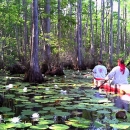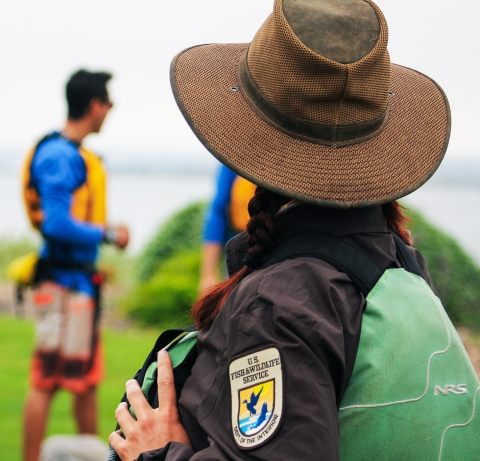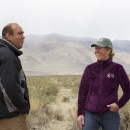
Turnbull NWR, in partnership with The Lands Council, will be hosting Earth Fest at the refuge on Saturday, April 26. The public is invited to join for a morning of environmental stewardship helping to support their public lands.

There will be prescribed burn operations happening at Turnbull NWR sometime March and May, depending on the favorability of weather conditions. Please do not call to report any smoke. If you have any questions, you may contact Cassie Roeder, Refuge Manager, at (509) 559-3021.
Visit Us
Turnbull National Wildlife Refuge is open between 6 am and 6 pm from November - April and between 6 am and 9 pm from May - October. Entrance the refuge is free. Visitors will find information on the refuge’s history, wildlife, and management at the interpretive kiosks at the refuge’s entrance, public restrooms, headquarters, and trailheads. The visitor contact station offers additional information and hands-on activities as well as books and other gift ideas at the Friends of Turnbull nature store. Over 10 miles of hiking trails, including 3 accessible trails, are available in the public use area. Blackhorse Lake offers an accessible boardwalk that allows all visitors easy lake viewing. All visitors are required to stay on designated trails and roads March 1 through August 15.
Location and Contact Information
- Turnbull National Wildlife RefugeView Details26010 South Smith Road Cheney, WA 99004-9326
About Us
Turnbull National Wildlife Refuge is located within a globally unique geological area known as the Channeled Scablands, created by massive scouring from ice age floods approximately 15,000 years ago. An extensive complex of deep permanent sloughs, semi-permanent potholes, and seasonal wetlands formed in the depressions left in the scoured landscape, while soils only centimeters thick on upland sites support ponderosa pine forests interspersed with grassland (steppe) communities on exposed basalt cliffs. Aspen is scattered throughout the area. The juxtaposition of all these contrasting habitats in such close proximity is unique to the Channeled Scablands and creates conditions of exceptional wildlife and plant diversity. This Refuge is managed by the Federal Government and a Washington Discover Pass is NOT required for access.
Tours
To schedule a program, tour, or field trip of Turnbull National Wildlife Refuge, contact Ranger Josh at 509-559-3034, or via email at joshua_contois@fws.gov.
What We Do
Every national wildlife refuge national wildlife refuge
A national wildlife refuge is typically a contiguous area of land and water managed by the U.S. Fish and Wildlife Service for the conservation and, where appropriate, restoration of fish, wildlife and plant resources and their habitats for the benefit of present and future generations of Americans.
Learn more about national wildlife refuge was created for a special purpose. Some were created to protect migratory birds, others to protect threatened or endangered species or unique habitats, while others fulfill another special purpose. Turnbull National Wildlife Refuge was established to protect migratory waterfowl, with a more recent focus on redhead ducks. All activities allowed on the refuge must be evaluated to make sure each activity will not conflict with the reason the refuge was founded.
Our Organization
The mission of the U.S. Fish & Wildlife Service is "working with others to conserve, protect, and enhance fish, wildlife, plants, and their habitats for the continuing benefit of the American people."
Turnbull National Wildlife Refuge has numerous programs to effectively manage wildlife and habitat native to this ecosystem and to provide visitor services compatible to our refuge's mission and goals. Wildlife Management-related programs include fire management, forest restoration, water and wetland management, private lands conservation, invasive species invasive species
An invasive species is any plant or animal that has spread or been introduced into a new area where they are, or could, cause harm to the environment, economy, or human, animal, or plant health. Their unwelcome presence can destroy ecosystems and cost millions of dollars.
Learn more about invasive species control, inventory and monitoring, and wildlife population management. To assist us in meeting our management goals and objectives we provide environmental education and volunteering opportunities.
Our Species
Turnbull supports a large variety of wildlife. Over 200 different kinds of birds have been recorded on the refuge. Of prime importance, the refuge conserves habitat for 25 species of nesting and migrating waterfowl including ducks geese and swans. Neotropical migratory songbirds, shorebirds and other water birds are found in abundance in riparian riparian
Definition of riparian habitat or riparian areas.
Learn more about riparian areas and wetlands. Mammals include moose, Rocky Mountain elk, white-tailed and mule deer, coyote, badger, river otter, porcupine, muskrat, beaver, bobcat and cougar. Numerous small mammals ranging from shrews to Columbian ground squirrels abound in different refuge habitats as well as a dozen reptile and amphibian species. The Channeled Scablands is a great haven for the 11 species of bats that have been documented at the refuge. A partial list of the most common, charismatic, or significant species can be found on iNaturalist. A complete list of species is listed at the bottom of the species page.
Get Involved
Whether you want to further conservation, learn more about nature or share your love of the outdoors, you’ve come to the right place. National wildlife refuges provide many opportunities for you to help your community by doing what you love. National wildlife refuges partner with volunteers, youth groups, landowners, neighbors and residents of urban communities to make a lasting difference. Find out how you can help make American lands healthier and communities stronger while doing something personally satisfying.
Projects and Research
Turnbull’s focus includes restoring and maintaining the native ecosystem processes of the Channeled Scablands. Habitat on the refuge is managed to sustain the diversity of flora and fauna native to this unique ecosystem. To achieve habitat diversity, the refuge reintroduces fire to fire-dependent plant communities, restores wetlands, deploys invasive species invasive species
An invasive species is any plant or animal that has spread or been introduced into a new area where they are, or could, cause harm to the environment, economy, or human, animal, or plant health. Their unwelcome presence can destroy ecosystems and cost millions of dollars.
Learn more about invasive species control, and plants native vegetation. Research is conducted on various habitats and wildlife to direct future management. Elk is also carefully managed through a limited-entry annual hunt to ensure a healthy regeneration of riparian riparian
Definition of riparian habitat or riparian areas.
Learn more about riparian forests.
You can help refuge staff by logging all of your observations on iNaturalist. This free app allows naturalists from all across the world collect and share their observations. The community on iNaturalist can help identify unknown species, track invasive species, and monitor phenological changes. What’s more, by recording and sharing your observations...










































